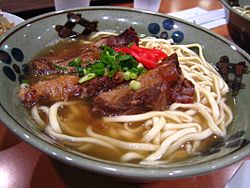Okinawa soba facts for kids

Sōki soba
|
|
| Alternative names | Soba, suba |
|---|---|
| Type | Japanese noodles |
| Place of origin | Japan |
| Region or state | Okinawa Prefecture |
| Main ingredients | Noodles (wheat flour), broth (konbu, katsuobushi flakes, pork) |
Okinawa soba (沖縄そば) is a special kind of noodle dish from Okinawa Prefecture, Japan. It's a very popular food there! Even though it's called "soba," which usually means buckwheat noodles in Japan, Okinawa soba is actually made from wheat flour.
The noodles are thick and chewy, a bit like udon noodles. When you eat Okinawa soba, it comes in a tasty soup. This soup is often compared to the broth used for ramen. The noodles can be round in some parts of Okinawa, like the Yaeyama Islands, or a bit flat in other areas.
The delicious broth is made with ingredients like konbu (a type of edible seaweed), katsuobushi (dried fish flakes), and pork.
Common toppings for Okinawa soba include:
- Kamaboko (a type of fish cake)
- Sliced scallions (green onions)
- A thick slice of stewed pork belly, called san-mai niku (meaning "three-layer meat")
- Sometimes, soki (boneless pork ribs) instead of pork belly
- It's usually garnished with beni shōga (pickled ginger)
If you like a little spice, you can add a few drops of kōrēgūsu. This is made from chile peppers soaked in awamori rice liquor.
Types of Okinawa Soba
There are a few different kinds of Okinawa soba, depending on what toppings you choose:
- Sōki soba (ソーキそば): This version comes with extra pork ribs, known as sōki in Okinawan.
- Tebichi soba (てびちそば): This one is topped with stewed pig's trotters (pork feet).
What's in a Name?
Today, the word soba in Japan usually means buckwheat, especially buckwheat noodles. The word soba originally meant "edge" in old Japanese. So, soba-mugi meant "edgy wheat" (buckwheat).
Around the 16th century, people started making thin noodles from buckwheat. This was called soba-kiri (meaning "soba cutting"). Later, it was shortened to just soba. Buckwheat noodles were mostly eaten in eastern Japan and weren't very popular in western Japan or Okinawa. Even today, buckwheat noodles are rare in Okinawa. They are called Nihon soba (Japanese soba) or kuroi soba (black soba) there.
Over time, the meaning of soba grew to include other thin noodles. For example, Yakisoba (stir-fried noodles) doesn't have any buckwheat. Shina soba, also known as Chūka soba (Chinese soba) or rāmen today, is also made from wheat flour. Okinawa soba fits into this group because it's made entirely from wheat.
After Okinawa became part of Japan again in 1972, there was a rule about what could be called "soba." This rule said that noodles had to have at least 30% buckwheat to be called "soba." In 1976, the Fair Trade Commission wanted Okinawa to stop using the name "soba" because their noodles didn't follow this rule.
However, the Okinawa Noodle Manufacturing Co-op talked with the Fair Trade Commission. They explained why their noodles were special. As a result, Okinawa soba was allowed to keep its name as a special exception.
History of Okinawa Soba
Some people think Okinawa soba might have started during the Ryūkyū Kingdom period, a long time ago. Chinese visitors might have brought wheat noodles to the royal court. However, we don't have clear proof that this led to the Okinawa soba we know today.
The first time Okinawa soba was written about was in 1902. Back then, during the late Meiji period, it was called Shina soba (Chinese soba), just like in mainland Japan. Several restaurants selling soba were open in Naha during the Taishō period.
Sadly, many soba restaurants were destroyed during the Battle of Okinawa in World War II. But Okinawa soba started to come back in U.S. internment camps, where people received wheat as food. In the 1960s, soba became even more popular when machines were invented to make the noodles. This made it easier for people to make soba at home, not just eat it in restaurants.
In 1968, the Japanese tradition of eating soba on New Year's Eve came to Okinawa. But instead of buckwheat noodles, people in Okinawa used their wheat noodles. Today, Okinawa soba is seen as a very important part of Okinawan culture.
Okinawa soba has even traveled to other countries! In Campo Grande, Brazil, it has become a local tradition. This is because many people of Okinawan descent live there. You can find special restaurants in the city that serve their own version of the dish.
Images for kids
Error: no page names specified (help). In Spanish: Okinawa soba para niños
In Spanish: Okinawa soba para niños


